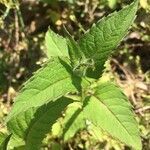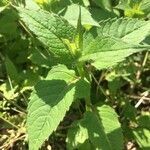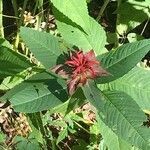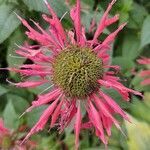Perennial 7–15 dm, often pilose at the nodes; lvs thin, ovate or deltoid-ovate to nearly lanceolate, 7–15 × 2.5–6 cm, acuminate, serrate, broadly acute to commonly rounded at base; petioles 1–4 cm; heads 2–4 cm thick (excluding the cors); bracteal lvs lanceolate, longer than the cals, usually red-tinted; fls inodorous, ornithophilous; cal 10–14 mm, glabrous to minutely puberulent, nearly or quite glabrous in the throat, the lobes 1–2 mm, subulate above a triangular base; cor scarlet to crimson, seldom deep red-purple, 3–4.5 cm, the nearly straight upper lip half as long as the tube; 2n=36. Moist woods and thickets; Me. to Mich., s. to N.J., W.Va., and O., and along the mts. to n. Ga. July–Sept. Hybridizes with no. 3 [Monarda clinopodia L.].
A plant which grows to 1 m high. It grows from seed each year. The leaf stalk is 2.5 cm long. The leaf blade is 10 cm long by 4.5 cm wide. It is papery. The teeth along the edge are unequal. The flower heads are 6 cm across. The flowers are tube shaped and about 12 form a round head. The flowers are purple-red.






